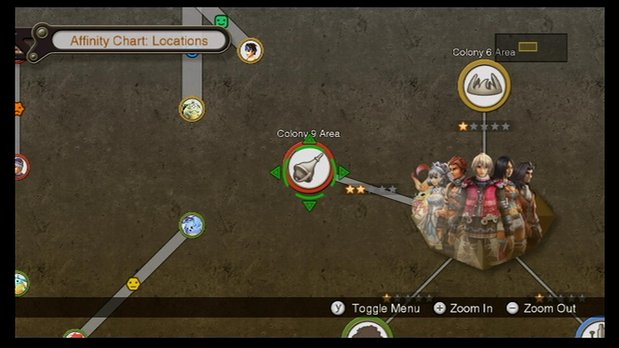Xenoblade Chronicles beginner's guide
Discover the subtleties of gem crafting, affinity, combat, and more with our detailed primer
Affinity
Affinity plays a crucial role in almost every aspect of Xenoblade Chronicles. If you want to get the most out of the game, you’ll need to manage the relationships between your party members, your party and the various regions, and certain NPCs.
Location affinity

Above: 50 hours in and those ungrateful Colony 9 bastards only give your party two stars
It’s a very long and slow process to reach the coveted 5-star affinity rank in an area - one that cannot be completed until the late stages of the game. However, raising affinity in a certain area opens up new quests and allows for more trading with NPCs, which means access to greater items and valuables such as additional skill tree branches.
One way to raise your affinity with a certain area is by completing quests. Quests are given by NPCs with white or orange exclamation points over their heads (which also appear on your mini map). It is common for one NPCs to have several quests for you at a time, so make sure to continue talking to them until the exclamation point disappears.
The other way to raise your Location Affinity rank is by linking NPCs. Whenever you talk to a named NPC, they’ll be added to your affinity chart. If you find related - not necessarily by blood - NPCs, a connection will be created on your chart. Connections can be enhanced through additional conversation and/or questing.
Party Affinity
Party affinity directly relates to how long you can maintain chain links, the number of skills you can link, and how many turns you have during gem crafting. There are several ways to raise the affinity between playable characters:
Gift giving - Collectibles can also serve as gifts. Select one from the menu and choose the “present” option. The result of this action is a very slight increase or decrease in affinity. Experiment to your heart’s content by saving beforehand.
Combat interactions - When characters become toppled, dazed, incapacitated, or their tension drops, you can move over to them and press b to perform an Affinity Cry. In addition to immediately improving your odds of winning, the affinity between the two characters is raised.
NPC interactions - This one’s simple. Just having a character in your party when accepting a quest from an NPC means a chance at raised affinity during the dialog exchange.
Heart-to-Heart moments - These are marked on your map, even if you haven’t uncovered the areas in which they exist. Don’t be alarmed if you cannot access most of these moments upon first discovering them. Only if you have reached a certain point in the story do the requirements of many of these moments become revealed, and even then, you’ll have to raise the affinity between the two characters to a certain level before you can access it. Each moment consists of two questions; answering correctly will give you a large affinity boost. Save your game before trying each one in order to avoid accidentally giving the wrong answers.
As you can see, the more you use two characters in the same party, the more their affinity will almost naturally rise. For this reason, it’s important to change things up as often as you can. Even if you prefer the awesome combination of Shulk, Reyn, and Sharla, sticking to it for the entire game will deprive you opportunities to raise the affinities between other characters.
Sign up to the GamesRadar+ Newsletter
Weekly digests, tales from the communities you love, and more


